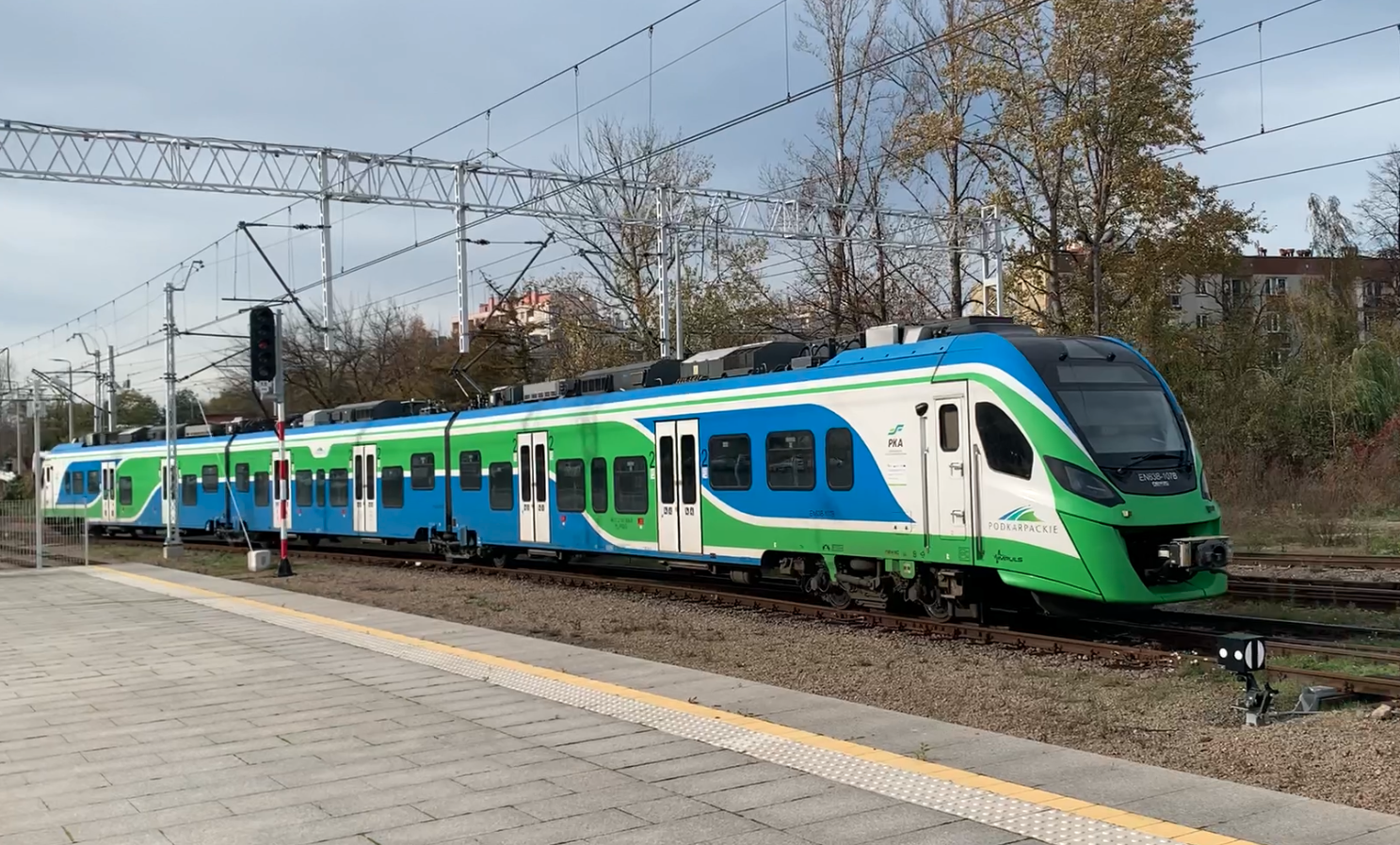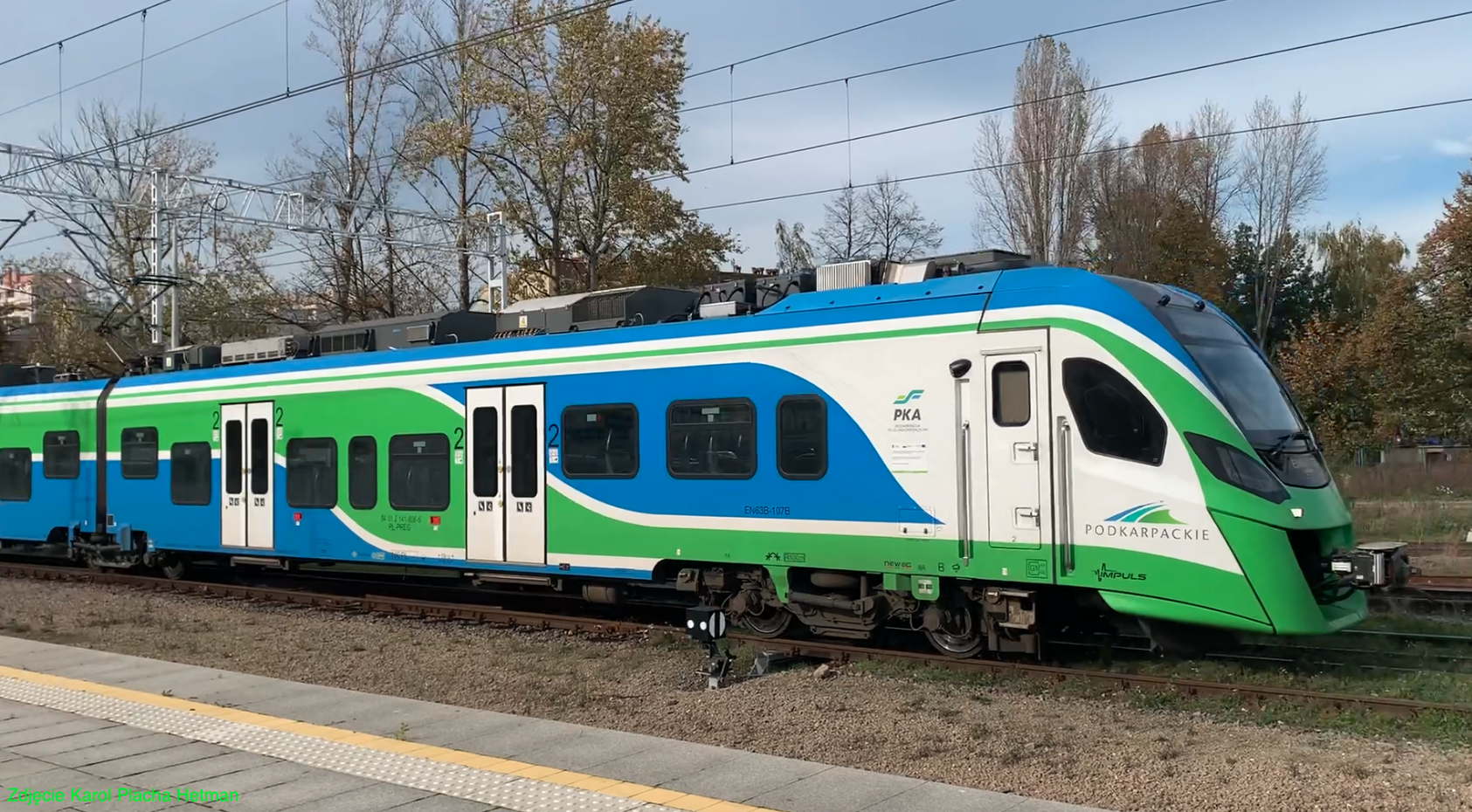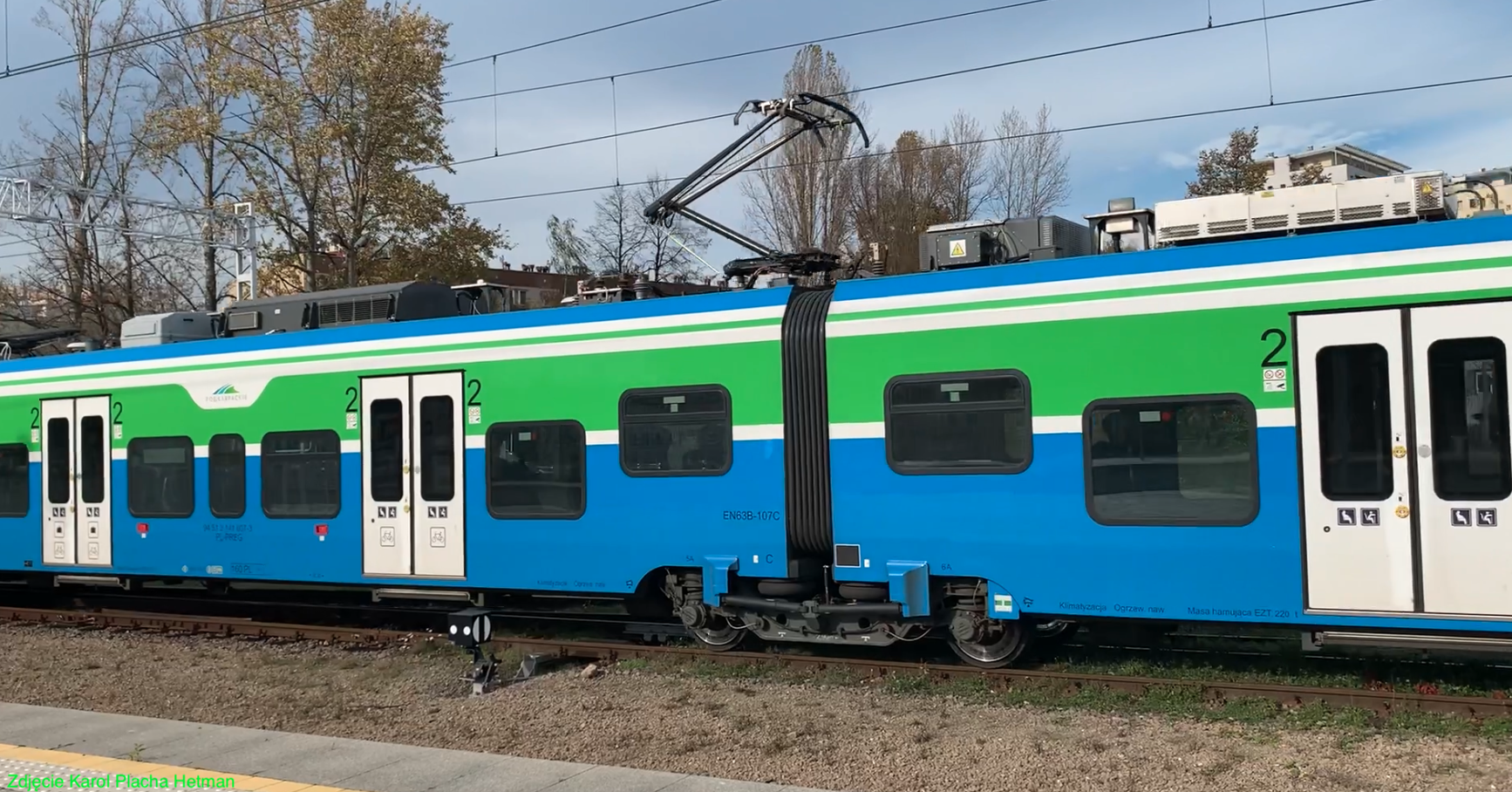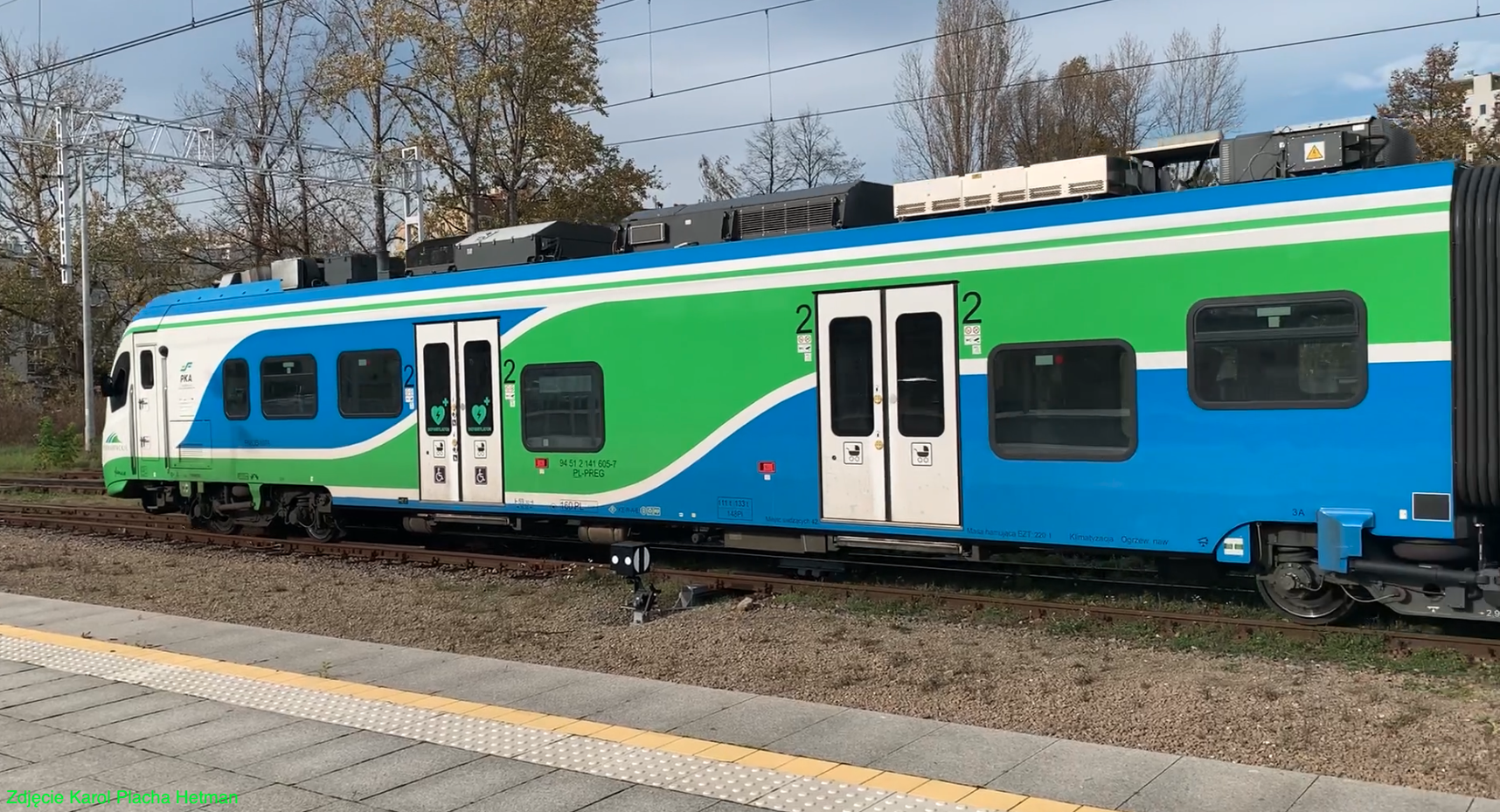Rzeszów 2023-12-02
Newag Impuls 2 Electric Multiple Unit.
EN63B-107, Koleje Podkarpackie. 3-car EMU.
Newag Impuls is a family of passenger (passenger) EMU trains built by the Newag plant in Nowy Sącz. The plant was established in 2005 on the basis of the Rolling Stock Repair Plant.




The origins of the "Impuls" EMU.
The interest of railway carriers in new EMU trains was great. However, there began to be a requirement for a low floor, as in trams and public transport buses. Polish manufacturers, in order to compete with foreign companies, decided to develop Polish structures that meet the new requirements. The first such vehicle was an EMU from the "Elf" family produced at the Pesa plant in Bydgoszcz. Newag also decided to build this type of vehicle, i.e. with a low floor, near the entrance door.
In Nowy Sącz, the first prototype marked type 31WE, i.e. a 4-car EMU, was built. On the night of February 18-19, 2013, during tests on the Central Railway Main Line, train 31WE set a speed record for a completely Polish vehicle of 211.6 km/h. Subsequently, type 35WE, which has 6 sections, and type 36WE, which has 3 sections, were developed. After them, the type 37WE, 2-section, was created. The last one was type 45WE, 5-section. On the night of August 28-29, 2015, the type 45WE train set a new speed record with a speed of 225.2 km/h. All these trains became one family called "Impuls".
In addition to the difference in the number of units (carriages), the trains differ in the number of entrance doors to individual carriages, the arrangement of seats, the number of toilets, places for people in wheelchairs and with bicycles, passenger information system, Internet access, 230 V sockets and USB sockets.
In addition to electric trains, diesel-powered trains have been developed for non-electrified routes. The drive is combustion engines built in the form of an MTU block. These are usually 2-piece trains. By the end of 2018, 167 "Impuls" EMUs were ordered, and by the end of 2020, 186 "Impuls" trains were ordered.
In 2020, the manufacturer Newag demonstrated the hit of the Polish industry, which is a hybrid train. In Polish conditions, the hybrid drive is a double drive: electric from the overhead line, and when the route is not electrified, the train runs on an MTU block combustion engine.
The first Newag "Impuls" train.
The construction of the first Newag Impuls type 35WE 6-car train began in November 2011. The idea was to develop an intercity train for routes of 200 - 300 km. Tests of the train began in April 2012.
In 2011, work began on the Type 31WE 4-wagon. This train was based on the solutions used in the 6-car EMU 35WE. In December 2012, the 31WE 4-car train was ready. Tests began in January 2013. On the night of February 18-19, 2013, during tests on the Central Railway Main Line, the type 31WE train reached a speed of 201.4 km/h, and during the last test it reached 211.6 km/h, setting a Polish record for vehicles designed and manufactured exclusively in Poland. Type 31WE trains were ordered by the Lubusz and West Pomeranian Voivodeships for their regional railways.
In September 2013, the first type 36WE-001, 3-car, was produced for the Podkarpackie Voivodeship and began testing and certification.
Type 45WE, 5-car, in November 2014, Koleje Mazowieckie was the first to order. To speed up tests and certification, a train built for the West Pomeranian Voivodeship was used, in which the number of wagons was increased to five. After obtaining the certificate, the train was stripped of one section and handed over to the user as type 31WE. On the night of August 28-29, 2015, the 45WE-010 train for Koleje Mazowieckie set another speed record on the Central Railway Main Line, reaching 225.2 km/h.
In 2015, the construction of a type 31WE 4-car train for PKP SKM Tricity began. The problem was that the platforms in Tricity were high, which meant raising the floors in the carriages. The train had to be redesigned, which was done.
In 2015, Newag won an order for an EMU for the Italian carrier Ferrovie del Sud Est.
In June 2016, the first train "Impuls 2" was built, which had 3 wagons. The front of the train has changed slightly. Additionally, there are side external doors to the driver's cabins.
The structure of the "Impuls" train.
The "Impuls" train is a standard-gauge electric multiple unit with a lowered floor. As standard, the floor is at a height of 760 mm from the rail head.
The train is a Class 2 train. The train does not have doors between the carriages, which means it is a single-space train. The interior is tailored to the customer's needs. The number of entrance doors may vary; one or two on each side of the wagon. Various passenger seating arrangements are used. Folding seats can also be installed. There may be a closed toilet in the passenger compartment. There is usually one toilet on the train, also adapted for disabled people. There may be space on the train for travelers with limited mobility, large luggage or bicycles. Near this area there is a door with a fold-out platform for wheelchair access. The vehicles may be equipped with an Internet access point, electrical sockets, ticket machines, ticket validators and a passenger counting system installed in the doors. The vehicles have a passenger information system in the form of loudspeakers, monitors and directional light boards. The trains have monitoring, air conditioning and heating with automatic regulation.
There is a machinery compartment between the driver's cabins and the passenger compartment. The trains are powered by 4 or 8 asynchronous electric motors with power ranging from 400 kW to 500 kW. That's why there's a lowercase "a" in the train type. The motors are controlled by inverters. The design speed of the train is 160 km/h and the acceleration is 1 m/s2. In the 2, 3, 4 and 5-car versions, the first and last bogies are 70RSNe drive bogies. Each bogie has one motor on its axle. Jacobs bogies, type 72RSTc, were placed between the wagons. The ends of two wagons rest on one bogie. The diameter of the wheels is 0.84 m, which allows the floor in the aisle to be significantly lower. A Knorr-Bremse braking system was used.
The 6-car version has a slightly different structure. The last bogie of the third wagon and the first bogie of the fourth wagon are the powered bogies. There is no Jacobs stroller here. Additionally, there are electrical cabinets in this compartment. Therefore, passengers only have a narrow corridor to move from the third to the fourth car.
All wagons are 2.84 m wide. The wagon height is 4.15 m. Each train has two half-type pantographs.
Train EN63B-107, Impuls 2.
The Impuls 2 train, EN63B-107, has the factory marking 36WEdb-007. The vehicle was built in December 2020 for the Podkarpackie Voivodeship Marshal's Office. The operator is PolRegio, a company of Koleje Podkarpackie, Podkarpacka Kolej Aglomeracyjna. The train is painted in the carrier's colors; white - blue - green. The seats are upholstered with navy blue fabric. The driver has a separate entrance door. Each carriage has two pairs of entrance doors.
Written by Karol Placha Hetman
